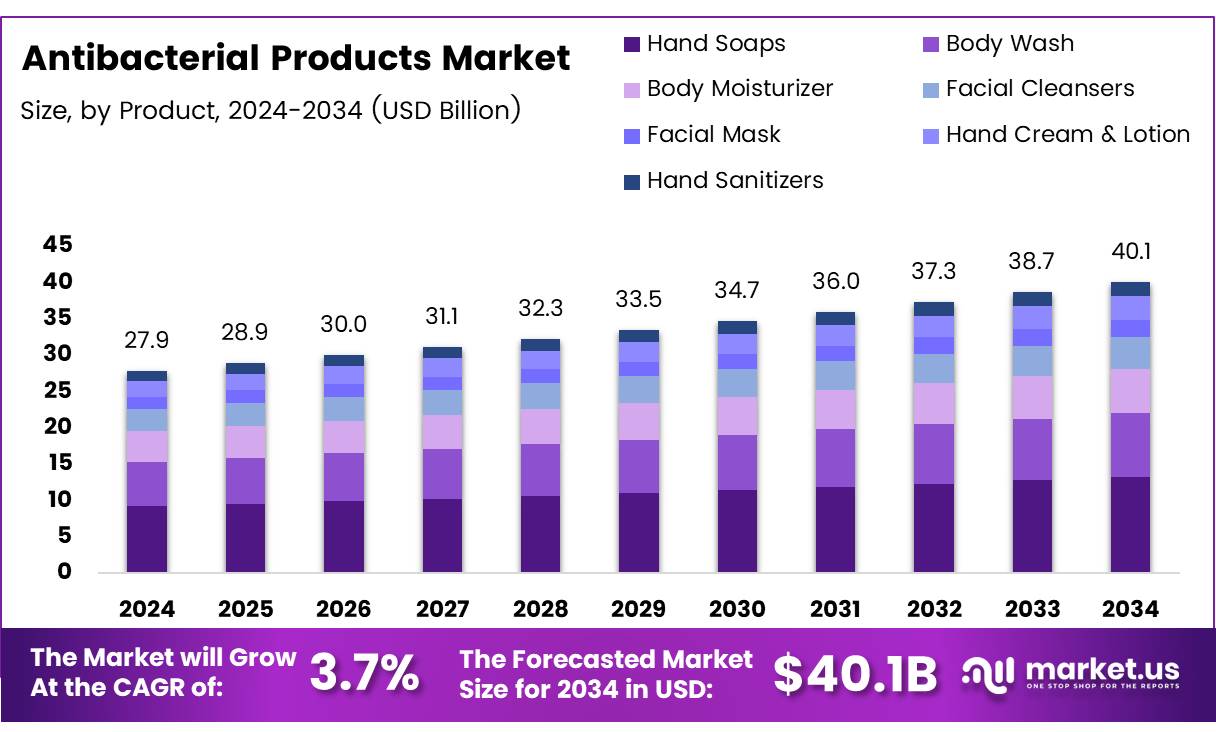Table of Contents
Introduction
The Global Antibacterial Products Market is projected to reach a valuation of USD 40.1 billion by 2034, increasing from USD 27.9 billion in 2024. Growing awareness about hygiene and infection prevention continues to drive the demand for antibacterial solutions worldwide.
As consumers increasingly prioritize health and cleanliness, antibacterial products such as soaps, sanitizers, and surface disinfectants have become essential. Furthermore, the ongoing emphasis on hygiene post-pandemic has strengthened market demand across both household and healthcare settings.
Transitioning into the forecast period, the market is anticipated to grow at a steady CAGR of 3.7%. Innovation in eco-friendly formulations, along with regulatory support for hygiene initiatives, positions the antibacterial products sector for robust expansion.

Key Takeaways
- Global Antibacterial Products Market projected to reach USD 40.1 billion by 2034, from USD 27.9 billion in 2024, with a CAGR of 3.7%.
- Hand Soaps lead the product segment with 33.5% market share in 2024, driven by heightened hygiene awareness post-pandemic.
- Hypermarkets and supermarkets are the leading distribution channels, favored for their extensive reach and convenience.
- Asia Pacific dominates the market with 46.8% share in 2024, propelled by high population density and growing health consciousness in China and India.
Market Segmentation Overview
In terms of products, Hand Soaps dominated with a 33.5% share in 2024, reflecting their necessity in daily hygiene routines. Consumers continue to value effectiveness, affordability, and easy availability, making hand soaps a preferred choice for both personal and institutional use.
Across distribution channels, Hypermarkets and Supermarkets led in 2024, benefiting from convenience and accessibility. These outlets offer consumers a comprehensive range of antibacterial products under one roof, increasing overall product visibility and consumer purchase frequency.
Drivers
Heightened Health and Hygiene Awareness: Post-pandemic, global awareness regarding hygiene has surged, prompting individuals, institutions, and governments to prioritize antibacterial solutions. The focus on preventive healthcare and sanitation has significantly influenced consumer behavior, resulting in sustained market demand.
Regulatory Support and Technological Advancement: Governments worldwide are enforcing stringent hygiene regulations across healthcare and food sectors. Simultaneously, advancements in antibacterial formulations have enhanced product efficacy and safety, encouraging greater adoption across industries.
Use Cases
Healthcare and Institutional Applications: Antibacterial products play a crucial role in hospitals, clinics, and care centers, helping to minimize cross-contamination and infection risks. Surface cleaners, soaps, and sanitizers are now mandatory hygiene tools in healthcare infrastructure worldwide.
Consumer and Household Usage: The widespread use of antibacterial soaps, wipes, and sprays in homes underscores their relevance in everyday life. Consumers increasingly integrate these products into daily routines to ensure cleanliness and safeguard family health.
Major Challenges
Rising Antibacterial Resistance: The overuse of antibacterial agents has accelerated bacterial adaptation, reducing the effectiveness of certain products. This resistance poses a threat to market stability, urging the industry to develop new, potent, and sustainable formulations.
Environmental Impact of Chemical Formulations: Some antibacterial compounds contribute to ecological imbalance and pollution. Regulatory restrictions on harmful ingredients challenge manufacturers to innovate eco-friendly alternatives without compromising product efficacy.
Business Opportunities
Expansion in Personal Care Segment: The growing demand for multifunctional antibacterial products—offering both hygiene and skincare benefits—creates avenues for innovation. Companies can develop moisturizing and natural ingredient-based formulations that align with consumer wellness trends.
Growth in Sustainable and Eco-Friendly Products: The increasing consumer shift toward biodegradable and non-toxic antibacterial products presents significant growth potential. Brands adopting green chemistry and sustainable packaging will likely capture expanding market segments.
Regional Analysis
Asia Pacific Dominance: Accounting for 46.8% of global market share, Asia Pacific leads due to population growth, urbanization, and enhanced public health initiatives in China and India. Government-led sanitation programs and local manufacturing expansion further strengthen regional market leadership.
North America and Europe Growth: North America’s market benefits from advanced healthcare systems and high consumer awareness. In Europe, stringent safety standards and an emphasis on sustainability drive innovation, particularly in countries like Germany, France, and the UK.
Recent Developments
- In October 2024, Bharat Value Fund invested Rs 122 Crore in Millennium Babycares to boost innovation in hygiene care products.
- In March 2024, 900.care raised €21 million in Series A funding to expand refillable hygiene product lines focused on sustainability.
- In October 2024, the Italian Government allocated $21 million to develop new antibiotics, vaccines, and diagnostics through a BU-led initiative.
- In April 2024, Peptobiotics secured $6.2 million in Series A funding to develop peptide-based biotic formulations for advanced health solutions.
Conclusion
The Global Antibacterial Products Market is entering a phase of consistent growth, supported by evolving hygiene awareness, regulatory initiatives, and innovations in sustainable solutions. As health consciousness becomes a central consumer focus, manufacturers emphasizing eco-friendly, effective, and multifunctional antibacterial products are poised to lead this expanding market. With robust regional demand, particularly in Asia Pacific, and ongoing research in antibacterial science, the market is set to achieve long-term resilience and profitability through 2034.
Discuss your needs with our analyst
Please share your requirements with more details so our analyst can check if they can solve your problem(s)



